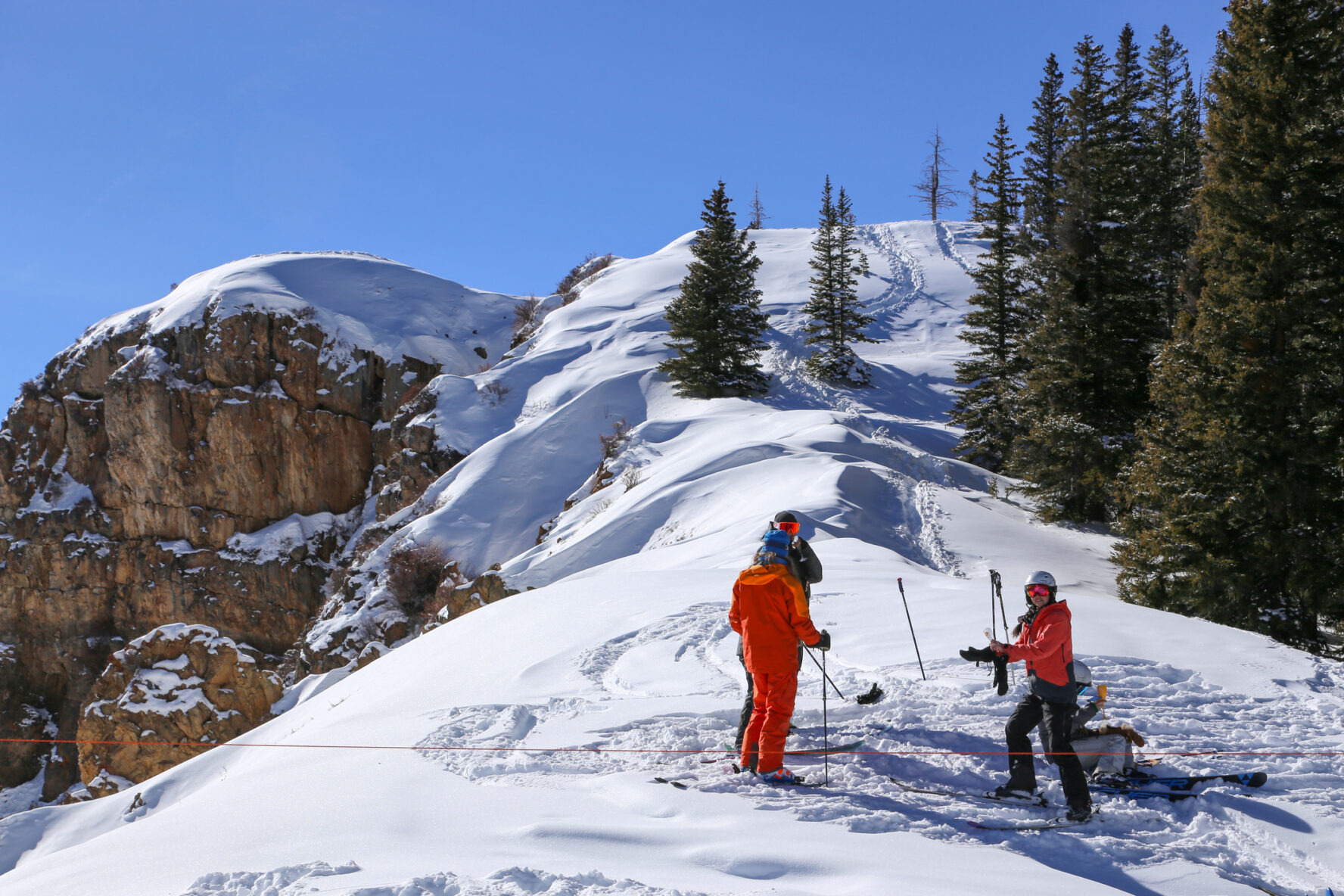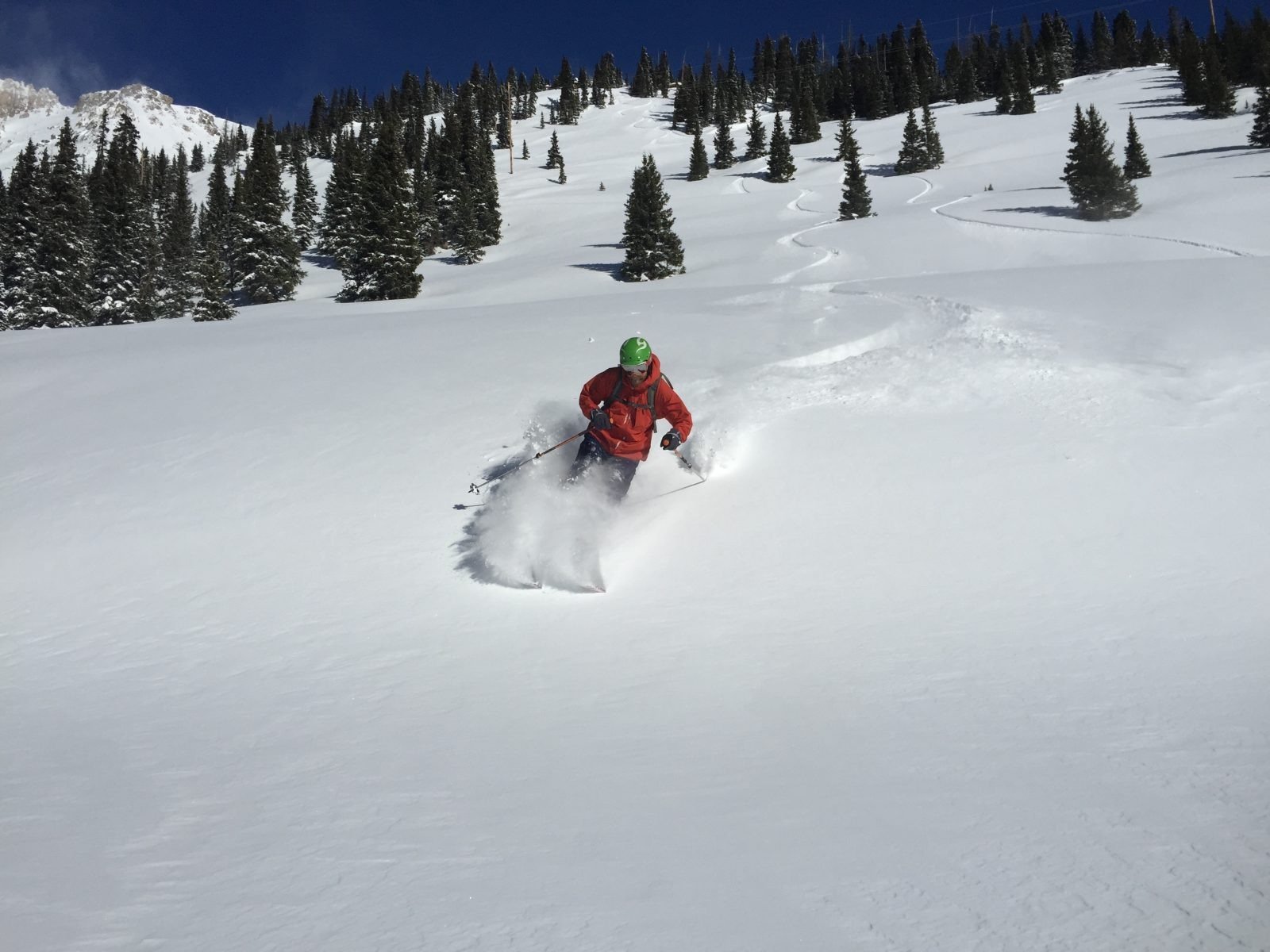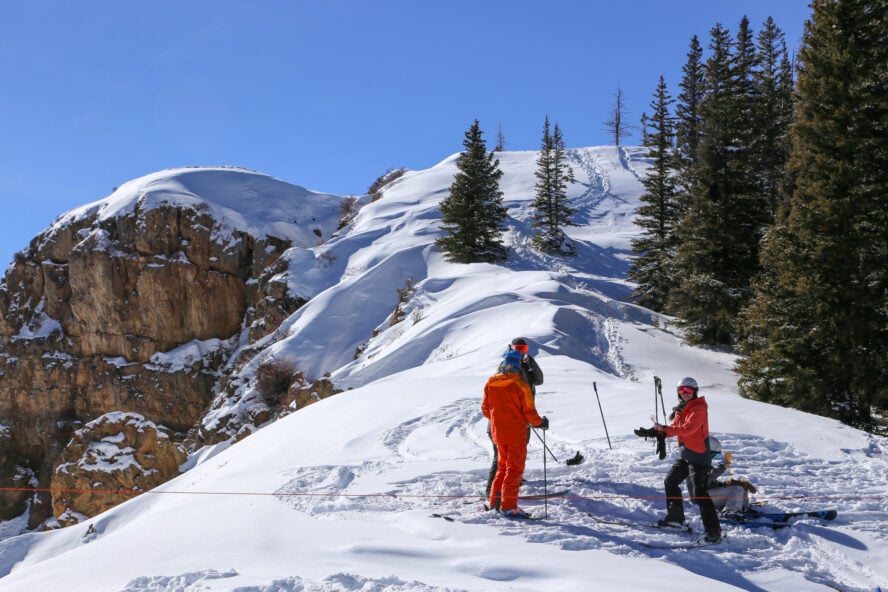There is every type of terrain imaginable in Colorado and no shortage of dry, deep powder. When the conditions are prime, it’s one of the few places you can ski year-round. From wide open meadows to steep, demanding, technical chutes, steep couloirs and perfect tree runs, this state has it all. Whether you’re making your first foray into backcountry skiing or you’ve been touring for years, there’s something on our list for everyone.
Beware, Colorado is avalanche country. A sketchy snowpack and plenty of charging riders can make for a deadly combination. Consider an AIARE avalanche course or hiring a certified, professional mountain guide before heading into the backcountry. Don’t be deterred, though, there’s plenty of safe, scenic skiing, too! Before adventuring here, consider these seven things that everyone needs to know about backcountry skiing in this winter wonderland. Also, it wouldn’t hurt to read up on the backcountry skiing etiquette in Colorado.
In collaboration with local guides and powder chasing pros, we’ve compiled the ultimate guide to backcountry skiing in Colorado, as well as a list of 10 bucket-list ski areas. Rest assured, there are dozens more—but our team of professional guides has to keep some of their secrets! Here are ten of our favorite Colorado backcountry skiing locations:
1. Rocky Mountain National Park
Can you ski in Rocky Mountain National Park? You bet! Towering 14,000-foot peaks, steep chutes, moderate glade skiing, it’s all there in one of the most scenic national parks on the continent. “Rocky,” as locals call it, hides dozens of stashes, most of them technical and challenging, so hiring a local guide increases your chances of finding the goods on the right day.

Challenging and Rewarding Terrain
Come spring, the steepest couloirs open up and the ski-mountaineering approaches the backcountry skiing in Jackson Hole in terms of challenge, commitment, and reward. Plum lines like the Taylor Glacier, Flying Dutchman, and maybe, just maybe…the Northeast Face of Notchtop will come into condition in April. Imagine skiing a 55-degree headwall under sunny Colorado skies…welcome to Rocky!
The terrain here is a steep-skier’s paradise, with lots of 40-plus-degree lines, making access difficult and unwise in all but the perfect conditions. Take care when venturing out. Some of the easier accessed terrains can be found at the Banana Bowl on Flattop Mountain or Tyndall Glacier. Hire a guide or take a ski mountaineering course to make the most out of your Rocky Mountain National Park ski touring.
I’ve skied some of the steepest lines of my life in Rocky and lived to tell the tale. With the right intel and prep, you can too. Here’s what you need to know.
Rocky Mountain National Park - Good to Know
Advanced to expert
Couloirs and chutes – all demanding and technical
14,259’ Longs Peak
Several trailheads offer skiing, but Bear Lake and Longs Peak offer the greatest variety of backcountry riding terrain
Kind Coffee in Estes Park has organic coffee and it opens early
Snow, slow to start, but often good coverage by January. Spring is prime time
March through June
Estes Park, Colorado
The Wheel Bar is a laid-back Tavern with pool tables and its own famous Bloody Mary
2. Crested Butte
The last great Colorado ski town
Crested Butte makes good on its rep as “the last great Colorado ski town” and will surprise you with all it has to offer. This down-to-earth town centers around mountain life and outdoor recreation, with plenty of accessible terrain to boot. Less crowded than Aspen and Vail, Crested Butte Mountain Resort has all of the usual family-friendly activities and amenities — but without the long lift lines and crowded slopes.
Five separate drainages mean there are hundreds of routes to choose from, no matter your level experience. Keep in mind that Crested Butte wasn’t built to serve its resort; the resort came later, and the town works hard to preserve its down-home way of life (so head to Aspen if you’re looking for luxury shopping and celeb sightings).

Get ready for steep and demanding terrain
If you’re willing to leave the resort behind, you’ll be in for a real treat. 4.5 hours north of Denver, this backcountry gem offers everything from hair-raising steep-skiing to cruisy “hero pow.”
The town’s location provides access to several peaks well over 10,000 feet: Crested Butte (12k), Cathedral Peak (13k) and a handful of 14ers, including Capitol and Pyramid – and that’s just in the immediate Elk Mountain Range.
Once you arrive in the Butte, check out how many different drainages depart from town – every direction you look, you can find epic lines to ski. From couloirs to high-angle descents, big bowl skiing and mellow touring, there’s everything in this area. Great terrain can be found at Red Lady Bowl on Mt. Emmons, First Glade on Snodgrass Mountain or head to the Ruby Range for some truly epic descents.
10 miles from town, sits Irwin, a place known to get three times as much snow — and the light, dry, perfect kind. You’ll need to utilize a backcountry guide in this area, and Irwin Guides have made a name for themselves as about the best you can get in these parts.
Consider hiring a guide for safety
Though there is plenty of safe, simple terrain around Crested Butte, keep in mind that you’re never far from committing, complex terrain. Decision-making skills in avalanche terrain are essential here. Even those with experience in navigation, terrain selection, and backcountry touring should consider hiring a guide. If you’re looking for a Crested Butte backcountry skiing map, Beacon Guidebooks has a collection that covers 72 zones throughout the area.
Crested Butte - Good to Know
Strong intermediate to expert
Chutes, bowls, couloirs
8,885′
Either by snowmobile or by bootpack and skinning, there’s an abundance of terrain available
Crested Butte is a hub of its own, but Denver is a 4.5 hour drive northeast
Head to Camp 4 Coffee for the best cup of joe in town
Crested Butte gets some of the largest snowfall in the state
Backcountry Skiing: Crested Butte by Andy Sovick
December through March (January and February are best)
Talk of the Town is a classic ski town bar in the heart of Crested Butte
3. Vail Pass
Offering a bit of everything – moderate terrain, steep chutes, snowmobile access, and easy approaches – Vail Pass is one of the best backcountry skiing destinations in the West. Combine the backcountry with world-class resort skiing at Vail, Copper Mountain, Breckenridge, Keystone, or A-Basin for an epic weekend in the mountains.
The Vail Pass summit reaches 10,662’, and its recreation area is a massive 55,000 acres. So, while the area is heavily trafficked, it is also huge. The north/east side of the pass is for non-motorized traffic, while the south/west side allows for snowmobiles, in addition to human-powered and cat skiing. Check out this Vail Pass brochure and map for more info.
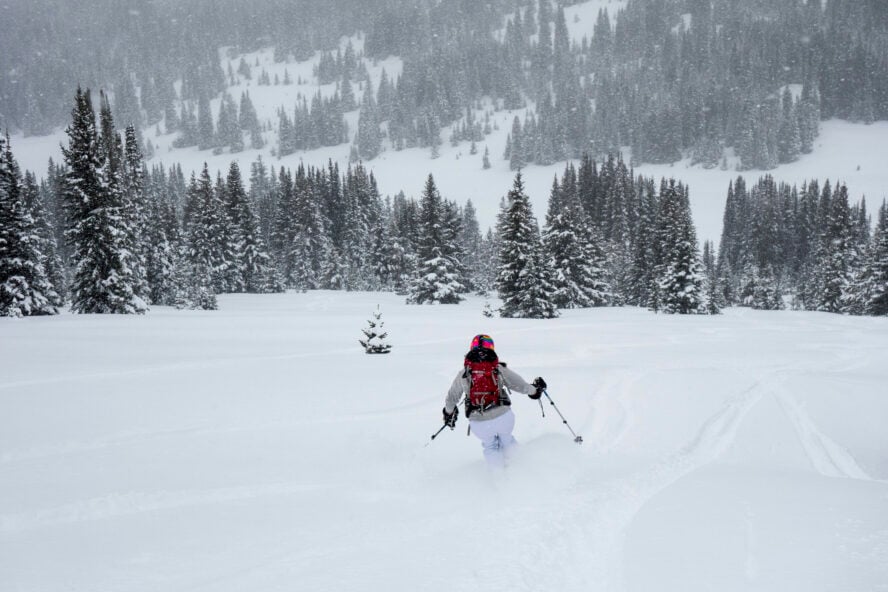
Beginner Routes in Vail Pass
If you’re a beginner to backcountry skiing in Colorado, Vail Pass is a great place to earn your stripes. There’s quick and easy access to the goods on Uneva Peak on the north side of I-70. The terrain here offers mellow lines and gentle slopes in the Hippy Trees and on the Dog Run. On the other side of the highway, it’s quite a bit busier, but a cat/sled road makes easy skinning towards moderate terrain in/around Ptarmigan.
Vail Pass Offers Routes for More Experienced Backcountry Skiers
Looking for something a little more challenging? Look on the southside of the Pass beyond Ptarmigan Hill and consider dropping in on the varied terrain of Boss Basin and, of course, Avalanche Bowl – an appropriately named feature which has unfortunately seen at least a couple fatalities.
If you find yourself on the northside at Uneva, the east-side chutes are steep and challenging if you’re looking for bigger angles and even bigger terrain. Avalanches are a real hazard in any of the steep terrains—know how to manage this hazard yourself, or hire a guide.
Vail Pass hides some of the best touring in the state. One-half the pass is motorized access and encompasses Vail Powder Guides' tenure, while the east side of the road is all human-powered ... and awesome!
Rob Coppolino —- IFMGA Guide and founder of Vetta Mountain Guides
Vail Pass - Good to Know
Beginner to expert
Wide meadows and alpine terrain, glades, bowls and, of course, chutes and cliffs
10,662’
Tons of runs, especially on the south side can be accessed via snowmobiles but for greater variety be ready to skin
You’ll need to grab your cuppa in Copper Mountain or Vail before heading out to the pass
Vail gets great snow from late fall into late spring. Check the avalanche advisory and be ready for variable conditions
Mid-January through April
Backcountry Ski & Snowboard Routes: Colorado by Brittany and Frank Konsella
Vail Pass is 15 miles south of the resort town of Vail.
Bart & Yeti’s in Vail is a long running institution with a rustic vibe
4. Aspen
Surrounded by the peaks of the Elk Mountains, Aspen is legendary for drawing in hordes of celebrities every winter. Sure, you can hang around town and spot the stars dining on bluefin tuna flown in from Tokyo, or you can discover why one of the best places for backcountry skiing in Colorado is more famous than anyone you’ll happen to catch a glimpse of. You could say that what Chamonix is for France, Aspen is for the U.S.—a thriving outdoor hub, and you can find here fantastic runs just like skiing La Vallée Blanche in Chamonix.
Backcountry skiing in Aspen offers tons of options for powder hounds and beginners alike, and depending on the terrain you seek and the distance you’re willing to work for it, there’s something for every level of skier. There’s also some great Aspen backcountry ski guides in the area to help you make the most of your trip, and in the summertime you’ll find some of the best mountain biking in Colorado there.
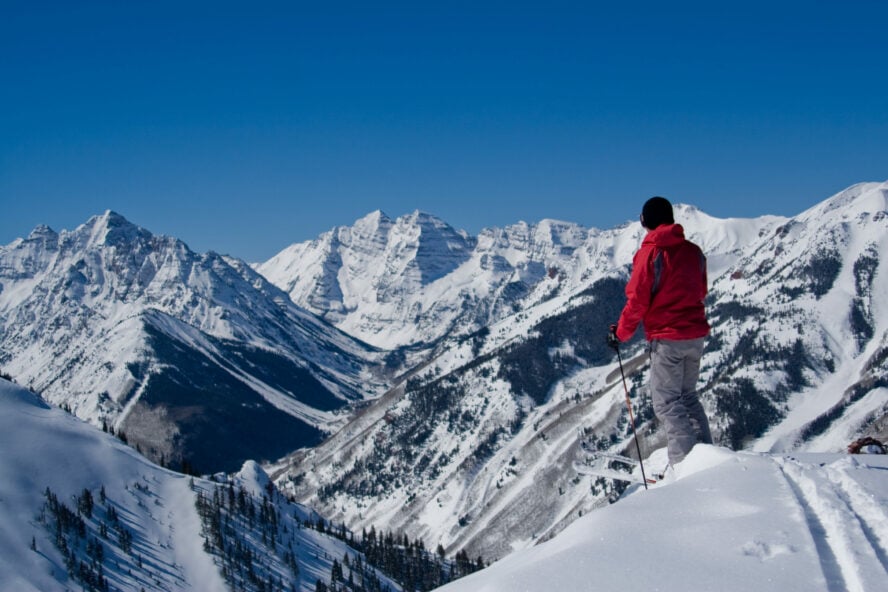
Where to stay in Aspen
The posh and famous ski resorts in Aspen – Ajax (Aspen Mountain), Aspen Highlands, Buttermilk (Tiehack), and Snowmass – are truly world-class. There’s lift-served access out of Ajax, Highlands, and Snowmass. While the classic resort options are convenient, a hut trip is the best way to go backcountry skiing in Aspen. Comfortable, spacious huts dot the mountains within sight of town and offer a great experience for families or a group of friends looking to experience Aspen’s true backcountry.
For newer skiers looking to develop their skills
Aspen visitors in-the-know love the phenomenal backcountry skiing right outside the gates, too, and without the lift lines. The Sugar Bowls — a series of open meadows just beyond the inbound gates at Buttermilk Mountain — offers lots of low angle terrain with super low avalanche risk to test out those new skis. Access this area from Government Trail gate. Another mellow tour is from Snowmass Resort to the Buttermilk area, across Burnt Mountain.
Bigger terrain, bigger rewards (and a ghost town!)
If you’re in search of bigger terrain with bigger challenges and rewards, you don’t have to travel too far in either direction from Aspen. Mount Hayden, just outside of Aspen via Castle Creek Road offers plenty of bowl skiing and higher angle descents. Also up that road, you’ll find the remnants of the old mining town of Ashcroft — a launching pad for adventure with access to backcountry ski trails and huts. Even further south is Mount Sopris, which offers steep terrain and committed couloir skiing, if someone in your group wants some expert terrain.
High alpine ski-mountaineering, gladed tree runs, and committing terrain right outside the ski areas -- this is Aspen and it's simply great! Plenty of options to keep you happy, even when the avalanche danger is up. Consider hiring a guide from Aspen Expeditions to find the goods.
Rob Coppolillo —- IFMGA Guide and founder of Vetta Mountain Guides
Aspen - Good to Know
All skill levels
Chutes, bowls, trees
7,908′
Because of the enormous ski lift infrastructure, chasing pow off the resort is an option. You’ll bootpack and skin, but lifts will get you most of the way. If you’re willing to dive further into the backcountry, there’s legendary touring out of Ashcroft, Marble, and Castle Creek.
Victoria’s Espresso is a local hot spot for coffee drinks…and wine
January through June
Marble and the West Elks receive as much snow as Alta and Snowbird, which if you’re not familiar, has some of the best backcountry skiing in Utah
Classic Colorado Ski Descents by Jon Kedrowski
Right in and around Aspen, CO
Aspen Brewing Company for drinks and eats. Home Team BBQ if you want to avoid the core.
5. Berthoud Pass
Once a fully functional ski hill, the Berthoud Pass ski area closed in 2001. By 2005, the lodge and chair lifts were removed. What’s left is a backcountry skier’s paradise, with runs suitable for all skill levels and pristine conditions. Sandwiched between Winter Park and Denver, Berthoud receives a bunch of traffic, but if you arrive early, you can still harvest the untracked and be gone before the hordes arrive.
The runs are well-established, the access is easy, and the powder is plenty due to Front Range storms. The snow is consistent, but the area also gets plenty of wind – avalanche danger can change by the hour.

Berthoud Pass has no shortage of runs
There are so many runs to choose from in Berthoud Pass, with ratings from easy to expert. Most runs can be done right from the pass, but some require you to hike or skin up. There’s excellent terrain on both the east and west sides of the pass, and although the east side is definitely more established, the west side boasts some truly epic spots.
For those less familiar with backcountry skiing, there are well-suited runs right from the parking lot. Parry Peak Ascent from the Berthoud Pass Summit is one of the most popular expert-level routes. Mines Peak and Second Creek are two popular intermediate level runs. “The Fingers” and Ditch Road are more suited to those with less experience.
Front Range Ski Mountaineering has detailed descriptions and maps of both the Berthoud Pass North, Berthoud Pass West, and other locations in the area, like Hells Half Acre and the East Side or Floral Park.
Friends of Berthoud Pass
The nonprofit group, Friends of Berthoud Pass, is committed to preserving the legacy of the area through safety, access and education. Founded by ski patrollers and backcountry riders, they offer classroom avalanche awareness presentations, which are all free and open to the public.
They informally monitor the area and work with the US Forest Service to help preserve the land while making it usable for backcountry use. They also provide a wealth of excellent resources, like Berthoud Pass backcountry skiing maps, as well as avalanche and weather links.
Berthoud Pass - Good to Know
Beginner to expert
Glades, steeps, cliffs and the abandoned ski resort area – the ski area is NOT avalanche controlled; treat it as backcountry
11,307’
It’s on Highway 40 so hitchhiking to the top is popular but you’ll also need skins or snowshoes
Berthoud Pass is just over an hours drive west of Denver and only 20 minutes south of Winter Park
Grab a cup at Winter Park’s Coffee and Tea Market or Waffle Cabin
It’s a real backcountry delight! On good years, Berthoud Pass can receive 500” or more
Rob Writz’s Backcountry Skiing: Berthoud Pass, Colorado
February through April
39°47′52″N 105°46′37″W
The Winter Park Pub is one of the go-to après-ski spots
6. Loveland Pass
Easily accessible off the I-70 highway, above Georgetown and only an hour from Denver, Loveland Pass attracts locals and visitors alike. While some may consider this area “easier,” it demands the same level of respect and caution as any backcountry area. Because it’s closer to Denver, you’ll likely run into other backcountry parties and need to hunt a bit for the goods.

Where to backcountry ski in Loveland Pass
With off-road access so convenient, look for the “short laps” just off the pass, south of I-70. There you’ll find gully runs that are short but usually untracked. At Mount Sniktau you’ll find good powderfields and steep drops from its northeast face. Head towards The Hippie Trees and you’ll find good tree skiing, obviously, cliffs and other terrain features, all of which are easily lapable.
Of course, if you want something a little more challenging, and scary, there’s always Dogshit Couloir and Widow Maker. You’ve been warned. Make sure to check out Loveland Pass backcountry ski conditions and stay safe.
If you’re looking for a detailed Loveland Pass backcountry ski map, Rob Writz of Front Range Ski Mountaineering has published a guidebook with one that covers 111 routes in the legendary area (it’s also tear-proof, waterproof, and made to accompany you in the backcountry).
Loveland Pass - Good to Know
Beginner to expert
Lots of tree skiing with open bowls in the higher areas
11,990′
Accessible off I-70 and you can bootpack/skin east or west from the summit parking area. Hitchhiking is definitely not frowned upon here so don’t miss the opportunity to help a fellow skier
Loveland Pass benefits from the usual snow in the high country, but also gets receives Colorado’s infamous “upslope” storms – sometimes adding as much as 100 inches of snow late winter into spring
February through April
Loveland Pass is a half hour drive west of Georgetown, CO
7. Hoosier Pass
If you’re looking for Breckenridge backcountry skiing, Hoosier Pass is just a short jaunt south of town and has a few stashes that can be untracked days after a storm. Though Hoosier Pass may not be the first pick for most Colorado backcountry skiers because it’s a bit obscure, that doesn’t mean it should be ignored!
Once a ski resort, it’s now another ghost town that offers two decent and easily accessed paths if you’re looking for a peaceful and chill ride, making it a great place for backcountry newbies. You can also make your way up to Bemrose Ski Circus for some more options. With safe, low-angle tree skiing and a couple of steeper bowls, Hoosier is a great go-to option when other areas are tracked out. Due to weather conditions, spring is the best time to ski in this area.

North Star Mountain and Tractor Bowl for Steep and Speedy Lines
Just west of Hoosier Pass sits North Star Mountain. The main northeast facing bowl on the east shoulder is called Tractor Bowl, which has some great steep lines. If you’re skiing Tractor, consider shuttling a car down to Monte Cristo Gulch so that you can ski some fun lines back down to the Montgomery Tunnel Diversion.
Quandary Peak Offers Versatile Routes for All Skill Levels
Just a few miles from Hoosier Pass is Quandary Peak, with four great routes: the East Bowl, Cristo Couloir, the North Gullies and the North Couloir. The East Bowl is the best choice for first-timers; you can easily scout your lines on the ascent. Cristo Couloir is a popular, wide-open couloir on the south face of Quandary and is arguably one of the best backcountry ski descents in Colorado. The North Gullies are for advanced skiers, with a steep, narrow chute that has few escape options. The North Couloir, AKA Quandary Couloir, is also an expert-only line.
Hoosier Pass - Good to Know
Beginner to expert
Mostly low angle chutes and bowls
11,542’
Along Highway 24, south Breckenridge
Breckenridge’s Cool River Coffee House
Continental powder and pack. The Ten Mile Range and Hoosier get epic winds; check before you go
Late winter into spring
Less than a half hour’s drive south of Breckenridge, CO
Head to Breckenridge and grab a drink at the legendary Gold Pan Saloon
8. Red Mountain Pass
Another mecca for backcountry skiers and riders, Red Mountain Pass sits in the San Juan Mountains, between the Old West towns of Ouray and Silverton. Drive up the Million Dollar Highway, one of the most scenic drives in the US (but potentially treacherous in winter), to park beneath 14ers and ski for the day.
Gorgeous, varied, and challenging, you need to ski it for yourself to see what all the fuss is about. With an endless variety of routes to explore — from laid-back tree runs to couloirs, traverses, summits and alpine bowls — you’ll find the ski touring in this area to be virtually limitless.
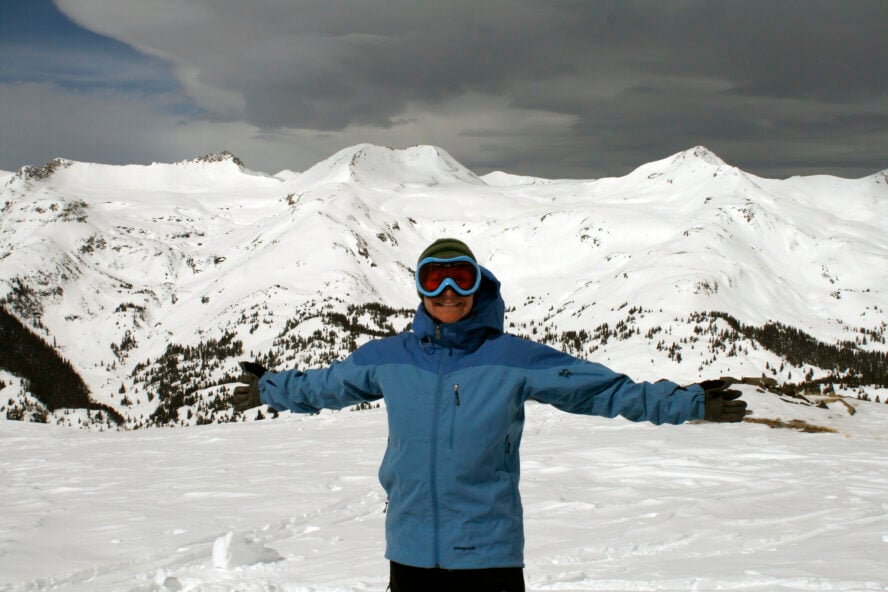
Red Mountain Pass guides
Book one of the beautiful, modern huts for a long week of ski touring in one of Colorado’s most beautiful venues or enjoy a stay at the luxe Red Mountain Alpine Lodge. Local mountain guides protect their secret stashes, saving them for the right days with the right guests, so your best bet is to book a guide for the best experience possible.
Red Mountain Pass is another of Colorado’s most active avalanche zones, so much so that Highway 550 has its own forecaster, which makes skiing with a guide all that much safer. The San Juan Mountain Guides are the local go-to experts in this area.
Red Mountain Pass is a mecca for backcountry touring.
13-year guide Justin Ibarra
Red Mountain Pass - Good to Know
Beginner (touring with a guide) to expert
Untouched chutes, bowls, gullies, and glades. Terrain varies which is why this is such a perfect spot
11,018’
It’s just along Highway 550, north of Silverton. Parking areas right off the road offer access
There’s no shortage of great cafes in Silverton, but I recommend Coffee Bear and Rocky Mountain Funnel Cake Factory.
Avalanche safety comes first. Conditions change by the hour here, so heads up and/or hire a guide
Winter to spring
Backcountry Skiing: Silverton, CO by Josh Kling
Red Mountain Pass is about a half hour drive south from Ouray and 20 minutes north of Silverton, CO.
Check out Siverton’s Golden Block Brewery or head down the street to Handlebars Food & Saloon for a true Wild West vibe (open seasonally).
9. Cameron Pass
Drive west out of the college town of Fort Collins, and you’ll soon find yourself in one of the best-kept secrets on the Front Range. The lesser-known ski-and-ride destination of Cameron Pass is situated in the northern part of the state, just a few miles north of Rocky Mountain National Park. It offers a quieter destination than some of the other popular areas on our list, and can be a good training ground for more challenging backcountry skiing destinations such as Jackson Hole.
Depending on the year, there are multiple areas in the Cameron Pass area that hold plenty of good snow year-round. Cameron Pass is a massive area with no shortage of excellent backcountry skiing routes. Many of these routes are visible from the road, but be prepared, they’re not accessible from your car, so you’ll need to skin up or snowshoe to get there.
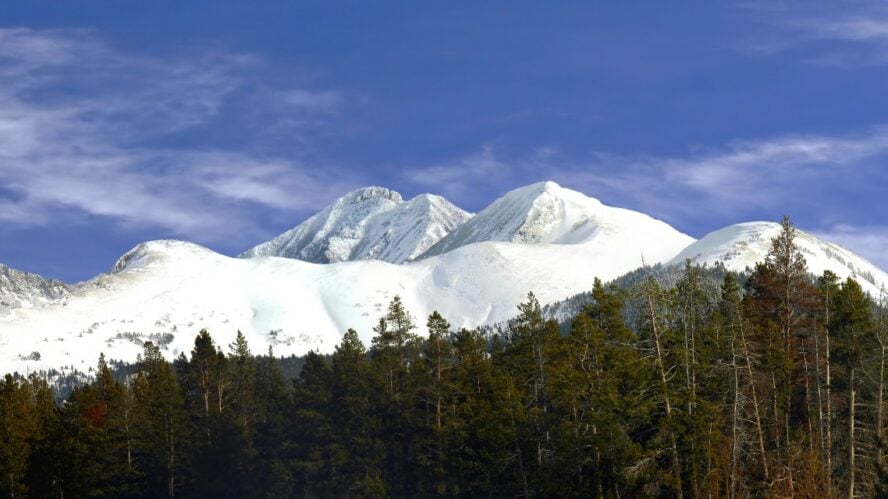
North Cameron Pass for Beginners and Pros Alike
North Cameron includes Hot Dog Bowl, a steep, long line that leads to a flatter section through the trees. Montgomery Pass and the surrounding bowls are a great spot for newcomers to the area, with simple, quick runs and well-marked trails, easy to locate with a North Cameron Pass backcountry ski map. Then you’ve got the North and South Diamond Peak routes. North Diamond is known for its excellent tree skiing with numerous places to explore. South Diamond is easy to access, has diverse terrain, and the routes are as epic as they are dangerous.
Nokhu Crags for Tons of Versatile Terrain
If you’re looking for steep couloirs, Nokhu Crags in South Cameron Pass has abundant spots with lots of versatile terrain. Breakfast Coulier and Grand Central Coulier are two popular spots out of many. Three Sisters is another great option because of its width. You need to exercise caution in this area as snow can be unstable. For spring skiing, the powder in this basin is world-class. The season can sometimes stretch to early summer.
Avalanche Risk in Cameron Pass
You’re not skiing in Tuckerman Ravine here; the snowpack in Cameron Pass is known to be quite dangerous and unpredictable, with massive avalanche potential. For this reason, backcountry skiers should be experienced, on high alert, and have avalanche education. This is one of those areas where adventuring with a certified backcountry guide is highly recommended.
Welcome to Nokhu Crags, which should be renamed “Couloir City” – because there’s at least a couple of couloirs here for every day of the week!
Brittany Walker Konsella, 14ersskiers.com
Cameron Pass - Good to Know
Intermediate to expert
Diverse terrain, with lots of deep powder, bowls, couloirs and glades
10,276’
Skinning, and you gotta work for it
Generally some of the highest snowfall totals on the Front Range. Make sure to check the forecast for strong winds and avalanche hazard
Winter to late spring
Backcountry Ski & Snowboard Routes: Colorado by Brittany and Frank Konsella
Cameron Pass is about an hour and a half drive west of Fort Collins, CO.
10. Monarch Pass
Monarch Pass is a family-friendly place that most visitors describe as laid back and uncrowded. With a welcoming vibe from locals and budget-friendly accommodation, Monarch is on the radar of many backcountry lovers. There’s touring within sight of Monarch Ski Resort and directly off the road. Monarch Pass tends to do well in El Nino winters, so check conditions. While the area doesn’t have as much varied touring as Vail or Berthoud Passes, it’s far less crowded.

Where to backcountry ski in Monarch Pass
On the south side of the pass, you’ll find The Perfect Trees, where you can run laps through trees on some longer runs. This area is best skied after a good snow dump. On the north side of Monarch Pass, there’s Gracies Slide, a rather short, but steep, run.
Half a mile east of the pass is the Snow Stake area; runs are super short and mellow, and avalanche danger is less of a concern here. If descending the east side of the pass you’ll see The Grand Couloir, a spot for experts, where the west side is known to hold snow into the early summer.
Monarch Pass - Good to Know
Beginner to intermediate
Nicely spaced trees and steep bowls
11,312′
Easy access from Highway 50
Brown Dog Coffee Company in Buena Vista, CO
The area usually gets over 350” of snow, but it’s not as consistent as some other Colorado locations
February through April
Backcountry Ski & Snowboard Routes: Colorado by Brittany and Frank Konsella
Monarch Pass sits along Hwy 50, between Salida and Gunnison, CO.
Sidewinder Saloon at Monarch Mountain has micro brews and good burgers
Additional Information About Backcountry Skiing in Colorado
When should I go backcountry skiing in Colorado?
The best time to ski in Colorado is between December and June. While early-season resort skiing in September or October is a possibility, the snowpack usually isn’t deep enough for safe backcountry skiing until December.
The first few months are best spent on low-angle runs. After the snowpack consolidates, the touring season often stretches into early June, so you have plenty of time for some serious spring slope shredding.
Glacier skiing in peak summer is a possibility, if the snowpack is deep enough to allow for it. Make sure to hit the slopes early, stick to steeper lines, and steer clear of avalanche terrain. Peak summer is also the best season to go hiking in Colorado, with numerous amazing trails popping up after snow melts.
Is it safe to go backcountry skiing in Colorado?
In Colorado, avalanches are your biggest risk. Colorado goes through strong warming cycles year-round, which leads to a higher avalanche risk. If you want your ski outing in Colorado to go by without a hitch, taking an AIARE Level 1, AIARE Level 2, or AIARE avalanche rescue course is highly recommended.
Also, if you’re planning on skiing in the summer, watch out for falling rocks and cornices. Lightning strikes are another big hazard, but there’s not much to be done about that.
Earn Your Turns in the Centennial State!
While you’ll likely find a metric ton of things to do in Colorado, backcountry skiing should top any reasonable adventurer’s bucket list. With unmatched terrain variety, year-round powder stashes and postcard-worthy vistas around every corner, Colorado gives even the most renowned backcountry meccas in the world a run (or ski) for their money.


















